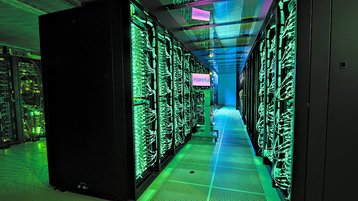A new hybrid supercomputer has been inaugurated at the Karlsruhe Institute of Technology (KIT) in Karlsruhe, Germany.
The €15 million ($17.8m) system, known as the Karlsruhe High-performance Computer (HoreKa), was inaugurated at the public research university in Baden-Württemberg last week.
“Creating knowledge to cope with the challenges faced by our society and our environment is a major part of our mission at KIT,” President of KIT, Professor Holger Hanselka, emphasizes. “Highly powerful supercomputers, such as HoreKa, are indispensable tools for the quick development of scientific findings and the corresponding solutions by our scientists. Moreover, HoreKa will provide our students with research experience they can gain nowhere else.”
HoreKa is a hybrid system that consists of two modules; HoreKa-Green comprises the part with computing accelerators based on GPUs, Horeka-Blue the module with standard CPUs; individually they provide Linkpack performance of 8 and 2.3 petaflops of respectively, but KIT says they provide a peak total as one combined system of 17 petaflops. HoreKa has been installed in a data center on KIT‘s Campus North constructed for its predecessor ForHLR system in 2015.
The Lenovo-manufactured system has 60,000 Intel Xeon "Ice Lake" Scalable Processor cores, 220 terabytes of main memory, 668 Nvidia A100 Tensor Core GPUs. A non-blocking Nvidia Mellanox InfiniBand HDR network with 200 GBit/s per port is used for communication between the nodes. Two Spectrum Scale parallel file systems offer a total storage capacity of more than 16 petabytes. Parallel file systems of HoreKa each provide up to four times the throughput of the previous ForHLR system.
“The impressive computing capacity of HoreKa will enable us to make many new discoveries in climate, energy, and materials research as well as in the life sciences,” says Professor Oliver Kraft, KIT VP for research. “The faster supercomputers process data, the more detailed and reliable will the simulations be. HoreKa does not only set new standards in terms of speed, but also in energy efficiency. This is important to supercomputing and to conducting responsible research.”
Available to scientists from all over Germany, the system will be used to research areas such as Earth system sciences, materials sciences, energy and mobility research, engineering, and particle physics.
HoreKa-Green ranks 52nd in the Top500 list of most powerful supercomputers, and 13th on the Green500 list of most energy-efficient HPC systems. Blue ranks 219th on the Top500 and 65th on the Green500.
“With HoreKa, we will not only strengthen Baden-Württemberg as a location of research. Within the National High-performance Computing Alliance, we will also make an important contribution to the German science ecosystem. High-performance computing is indispensable in cutting-edge research and we are proud to actively steer this development with our investments,” said Theresia Bauer, Baden-Württemberg Minister for Science, Research, and the Arts.

